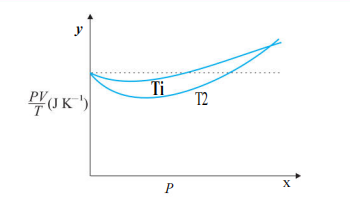Complete Solutions to EXERCISE of chapter KINETIC THEORY of Class 11 book with complete answers and questions
| Class 11 | PHYSICS |
| Chapter | KINETIC THEORY |
| PSEB | EXERCISE |
| Number Of Questions | 17 |
| Academic Year | 2023-24 |
Estimate the fraction of molecular volume to the actual volume occupied by oxygen gas at STP. Take the diameter of an oxygen molecule to be `3overset@A`.
02:15View SolutionMolar volume is the volume occupied by 1 mol of any (ideal) gas at standard temperature and pressure (STP : 1 atmospheric pressure, `0^@C`). Show that it is 22.4 litres.
01:51View SolutionFigure 13.8 shows plot of `PV//T` versus P for `l.OOxxlO^-3` kg of oxygen gas at two different temperatures. What does the dotted plot signif?:
 02:38View Solution
02:38View SolutionFigure 13.8 shows plot of `PV//T` versus P for `l.OOxxlO^-3` kg of oxygen gas at two different temperatures.Which is true: T_1 > T_2 or T_1 < T_2?:
 01:53View Solution
01:53View SolutionFigure 13.8 shows plot of `PV//T` versus P for `l.OOxxlO^-3` kg of oxygen gas at two different temperatures What is the value of PV/Twhere the curves meet on the y-axis? :
 03:51View Solution
03:51View SolutionAn oxygen cylinder of volume 30 litres has an initial gauge pressure of 15 atm and a temperature of `27 ^@C`. After some oxygen is withdrawn from the cylinder, the gauge pressure drops to 11 atm and its temperature drops to `17 ^@C`. Estimate the mass of oxygen taken out of the cylinder (`R= 8.31 J mol^-1 K^-1 ’, molecular mass of `O_2` = 32 u)
04:14View SolutionAn air bubble of volume `1.0 cm^3` rises from the bottom of a lake 40 m deep at a temperature of `12^@C`. To what volume does it grow when it reaches the surface, which is at a temperature of `35^@C` ?
03:56View SolutionEstimate the total number of air molecules (inclusive of oxygen, nitrogen, water vapour and other constituents) in a room of capacity `25.0 m^3` at a temperature of `27 ^@C` and 1 atm pressure.
05:03View SolutionEstimate the average thermal energy of a helium atom at room temperature `(27 ^@C)`
01:47View SolutionEstimate the average thermal energy of a helium atom at the temperature on the surface of the Sun (6000 K)
01:38View SolutionEstimate the average thermal energy of a helium atom the temperature of 10 million kelvin (the typical core temperature in the case of a star)
01:38View SolutionThree vessels of equal capacity have gases at the same temperature and pressure. The first vessel contains neon (monatomic), the second contains chlorine (diatomic), and the third contains uranium hexafluoride (polyatomic). Do the vessels contain equal number of respective molecules ? Is the root mean square speed of molecules the same in the three cases? If not, in which case is `u_rms` the largest ?
04:22View SolutionAt what temperature is the root mean square speed of an atom in an argon gas cylinder equal to the rmsspeed of a helium gas atom at `-20 ^@C` ? (atomic mass of Ar = 39.9 u, of He = 4.0 u).
03:30View SolutionEstimate the mean free path and collision frequency of a nitrogen molecule in a cylinder containing nitrogen at 2.0 atm and temperature `17 ^@C`. Take the radius of a nitrogen molecule to be roughly `1.0overset@ A`. Compare the collision time with the time the molecule moves freely between two successive collisions (Molecular mass of `N_2` = 28.0 u).
04:18View SolutionA metre long narrow bore held horizontally (and closed at one end) contains a 76 cm long mercury thread, which traps a 15 cm column of air. What happens if the tube is held vertically with the open end at the bottom ?
07:33View SolutionFrom a certain apparatus, the diffusion rate of hydrogen has an average value of `28.7 cm^3 s^-1`. The diffusion of another gas under the same conditions is measured to have an average rate of `7.2 cm^3 s^-1`. Identify the gas
02:55View SolutionGiven below are densities of some solids and liquids. Give rough estimates of the size of their atoms :
 05:45View Solution
05:45View Solution
EXERCISE questions and complete solutions for chapter KINETIC THEORY of PSEB of Class 11
